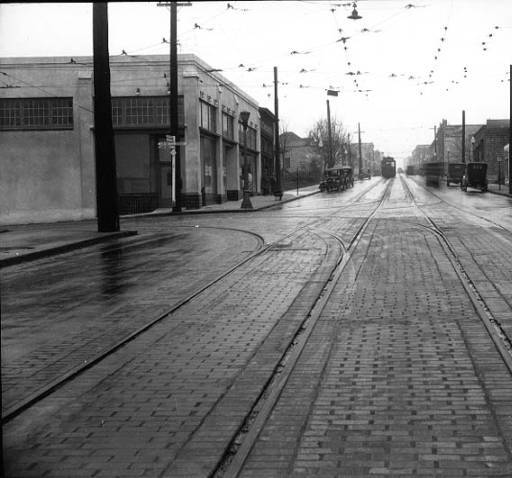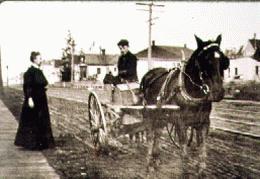Site Report #3: THE AUDIO TOUR

Image of University Way looking North from NE 40th Street taken in 1920. You can see the tracks that had been placed in 1895, and where the streetcars would run to get to "University Station". Published by Seattle Photograph Collection, sourced from UW Special Collections, taken c.a. 1920.

The Hardt Apartment photo from 1928. The Hardt Apartments were owned by Sidney Hardt from 1922 until the late 1950s. THe two storefronts of the brick building were occupied by Melrose Beauty Shop and a chirpractor. The building is now the current Bucklin Building. This is a great representation of early commerical architecutre. The building to the left was probably the previous ice cream shop known as the "Churn" which later in 1960s became a pizza parlor, which eventually became the current Big Time Alehouse in 1988. Published by Seattle.gov, sourced from Seattle Municipal Archives Photograph Collection, taken 1928.

An image of Hurd Porter driving the Murphy Meat Market Wagon, photo taken in 1905. The first paved roads on University Way NE did not arrive until 1909, thus this is a great representation of the still hardly developed University District are. The paving of the roads came at a perfectly timed moment as the University got ready for the Alaska-Yukon Exposition that summer. Published and sourced by History Link, photographer unknown, taken 1905.

This is an aerial view of block 23 taken in 2012. It has the planned layout for a new student housing building, which is currently in the process of being constructed. At this point in time (February 2017), a lone residential house remains on the building site, but will soon be torn down to make room for the finishing touches on this construction site. Created by Caron Architecture, taken in 2012.
Audio Tour of Block 23. Recorded and written by Alisa Kean, 2017.
TRANSCRIPT OF AUDIO TOUR:
It’s hard to imagine “The Ave” of University District to look any different than it does today. But even this area had humble beginnings. Let’s go back in time to look at the development between NE 42nd and NE 41st street, sandwiched in the middle of Brooklyn Way NE and University Way NE.
Around 1890, this area was undeveloped, and plans were made to plan the “Brooklyn Addition”- aka the U District. It was also then when the tracks of a streetcar to the District were completed, and by 1900 these tracks were known as the University Line(Pulkkinen). Right on the corner of 42nd and University Way was where people would get off for “University Station” (Menges). (See image).
Fast forward to 1909 – the first paved roads were added to University Way just in time for the increased traffic from the Alaska-Yukon Gold Rush Exposition that upcoming summer (Dorpat). (View 1905 image for pre-paved ave pic).
By the 1900’s the community was growing, and with this came an influx of religious groups. Around 1901 the Christ Episcopal Church began meeting in Sherrick’s Hall above a drugstore at NE 42nd St and University Way, which is the current Starbucks location(Nielsen, 12). At this time, the University Baptist Church met in that same hall, creating some scheduling conflicts.
On the corner of 42nd and Brooklyn, you will notice an older building, home to a few Asian restaurants – but the building itself seems to look like a church – which makes sense because in 1906 this structure was built for the Brooklyn Methodist Episcopal Church. Another renovation was made in 1984 to make it a commercial building, due to the growing community population and influx of commercial business.
Additionally, on University Way between 41st and 42nd you’ll notice a brick building marked “Bucklin Building”, and flanked by Big Time Brewery and Alehouse. This building combination was erected in 1916 and known as the “Hardt Apartments” from 1922 to 1950 (. It's a great example of some of the earliest brick masonry left on the Ave. (See 1928 Hardt Apt. image).
Soon after, 1929 hit and with it came the Great Depression which wasn’t without consequences. Some of it was positive. The UW Director of Drama at the time put on productions at his theaters “The Studio” on 42nd and University Way, because the Depression became an inspiration for various art pieces(Tate).
The Depression also led to the Seattle Municipal Street Railway’s bankruptcy, which led to rehabilitation plans in 1939 to create the gas powered bus system. By 1941, the streetcars were completely obsolete(Seattle Municipal Railway).
As 1950 rolled around, returning veterans carried out benefits of the "G.I.Bill" and the enrollment of students at the University of Washington dramatically grew. With this came an overflow of traffic, and the streets surrounding the University Way NE side of my block saw an increased numbers of parking meters as well as pedestrian traffic
If you looked down the ave from NE 42nd and University Way NE in the 1967 you probably saw the groups of "flower children" amassing "The Ave", promoting the "Summer of Love". Perhaps you would even see the Ave's Hippie riot of 1969, that resulted in damage to surrounding retail stores through broken windows, but also led to the first University District street fair you would see in 1970 starting from NE 41st street and University Way NE(Pulkkinen).
Now it’s 2017- the florist that used to exist is now a Starbucks, the church is a home for restaurants, and the theater no longer exists. The residential houses on the Brooklyn side are being torn down to make room for more student housing. U District evolves to accommodate for community changes, but the history of the block will maintain the same story. (See current topographical site).
